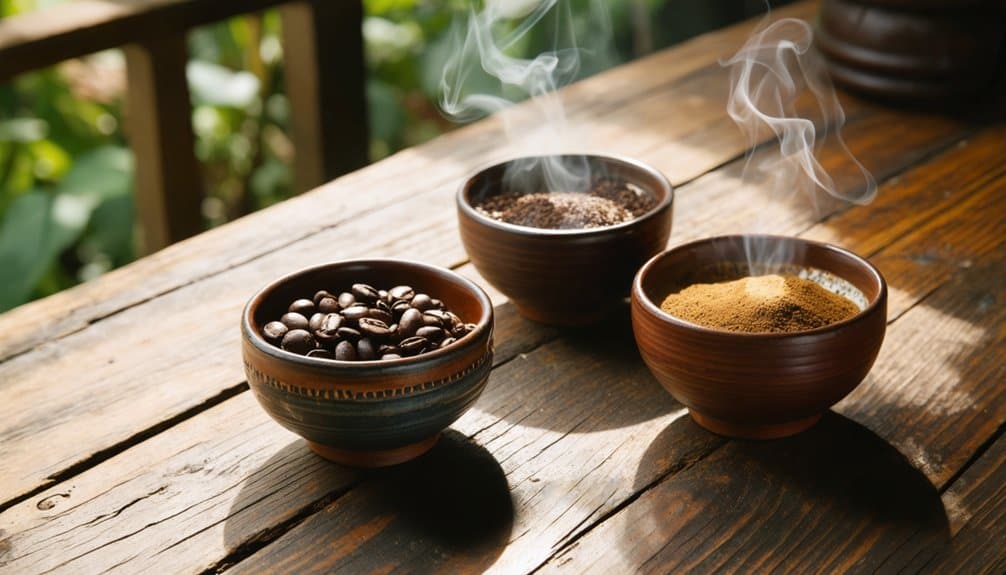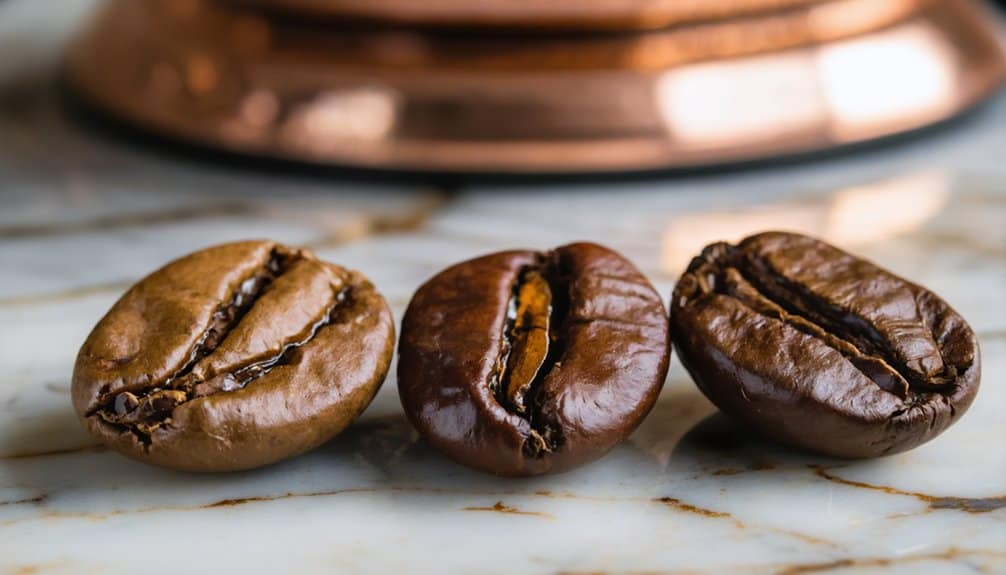You’ll uncover distinct coffee roasting approaches across seven major regions, from Ethiopia’s light ceremonial roasts to Indonesia’s bold dark profiles.
Each area’s climate, altitude, and cultural heritage shape its roasting style: African beans shine at lighter temperatures, Central American coffees excel at medium roasts, while Indonesian varieties develop rich complexity in darker profiles.
Understanding these regional techniques will transform how you appreciate coffee’s global diversity and help you master your own roasting expedition.
Key Takeaways
- Light roasts best preserve Ethiopian and Kenyan beans’ natural fruity notes, while dark roasts enhance Indonesian beans’ bold, earthy characteristics.
- Brazilian beans require slower roasting at medium-dark levels to achieve their signature chocolate and toasted nut flavors.
- High-altitude Guatemalan beans perform optimally between 410-428°F, developing complex flavors and maintaining their natural sweetness.
- Traditional African roasting methods include Ethiopia’s baret metad technique, producing three distinct strength levels through multiple roasting rounds.
- European roasting innovations established the Vienna Roast profile, featuring darker, bittersweet flavors ideal for French Press and espresso preparation.
The African Coffee Belt: Ethiopia, Kenya, and Tanzania’s Roasting Traditions

Three distinct roasting traditions shape the African Coffee Belt, with Ethiopia, Kenya, and Tanzania each contributing unique approaches to coffee preparation.
In Ethiopia, you’ll find beans roasted on a traditional baret metad, where they’re carefully monitored until they crackle and release their signature aromas.
Kenya’s coffees, renowned for their bright acidity, benefit from high-altitude growing conditions and washed processing methods.
Tanzania’s approach differs by region, with its prized peaberry coffees receiving special attention through hand pulping and sun-drying.
When roasting, lighter profiles preserve Ethiopia’s subtle notes, while Tanzanian beans shine at diverse roast levels.
The Ethiopian ceremony traditionally requires three rounds of coffee, beginning with the strongest brew called Abol, followed by Hueletanya and Sostanya.
Central American Roasting: Guatemala and Costa Rica’s Sweet Spot
You’ll find Central American coffee roasting centers on achieving the perfect medium roast, especially with Guatemala’s dense, high-altitude beans that shine between 410-428°F (210-220°C).
Both Guatemala’s chocolate-forward profiles and Costa Rica’s bright citrus notes benefit from careful temperature control through initial crack, letting their natural sweetness develop without burning off the complex flavor compounds.
When you’re working with these regions’ beans, focus on extending the time between initial and second crack to reveal their characteristic mountain-grown qualities, from Guatemala’s rich cocoa to Costa Rica’s clean, citrus finish.
Guatemala’s eight distinct growing regions contribute to an incredible diversity of flavor profiles, making proper roasting technique crucial for highlighting each area’s unique characteristics.
Medium-Roast Mountain Profiles
While Central American coffee beans demand careful attention during roasting, Guatemala and Costa Rica’s high-altitude arabica varieties particularly shine when given a medium roast profile.
You’ll find their dense beans require higher preliminary temperatures, but patience yields remarkable results.
The rich volcanic soils contribute significantly to their unique flavor development during the roasting process.
To reveal their full potential, aim for initial crack around 196°C, finishing between 201-205°C. You’ll capture the sweet spot where complex flavors emerge without sacrificing brightness.
Watch for the development of caramel notes in espresso or clean sweetness in filter brews.
Remember, these mountain-grown beans thrive with precise temperature control and careful monitoring throughout the roasting process.
Chocolate-Citrus Flavor Balance
Achieving the perfect chocolate-citrus balance in Central American coffees requires mastering the delicate interplay between roast development and bean density.
You’ll find that Guatemalan beans, grown at elevations up to 16,400 feet, develop complex flavor profiles that shine in medium roasts.
To capture both chocolate richness and bright citrus notes, you’ll want to maintain shorter roast times at temperatures between 180-250°C.
Focus on controlled development stages to preserve the beans’ intrinsic sweetness while highlighting their regional characteristics.
Remember, high-density mountain-grown beans need precise initial temperature control to reveal their full flavor potential.
The rich warm tropical climate of Central America particularly enhances the chocolate undertones in these specialty beans.
Brazilian and Colombian Coffee: South America’s Roasting Legacy

South America’s two coffee giants, Brazil and Colombia, have shaped the global coffee roasting landscape with distinct approaches that reflect their unique growing conditions and cultural heritage.
When you’re roasting Brazilian beans, you’ll want to take it slow due to their lower density. Aim for medium-dark roasts to bring out their signature chocolate and toasted nut notes, along with subtle citrus undertones.
Colombia’s finest regions like Minas Gerais contribute to 50% of Brazil’s production, making it a powerhouse in coffee cultivation.
Colombian beans require a more nuanced approach, with regional variations dictating your roast levels. You’ll find Tolima beans shine with lighter roasts, while Nariño beans develop their full potential in darker profiles.
Both origins excel in espresso applications.
Indonesian Coffee Heritage: Sumatra and Java’s Dark Roasts
When you’re exploring Indonesian coffee’s rich heritage, you’ll find that Sumatra and Java offer distinctly different dark roast profiles shaped by their unique wet-hulling process and volcanic growing conditions.
Java’s medium-bodied beans develop herbal notes and bright acidity when dark roasted, while Sumatra’s full-bodied beans transform into an earthy, spicy cup with remarkably low acidity.
These regional characteristics stem from centuries-old cultivation methods, where the interplay of high altitude, volcanic soil, and traditional processing techniques creates beans that excel in dark roast applications.
The Giling Basah process used by local farmers enhances these distinctive flavor profiles, making Indonesian coffee highly sought after in global markets.
Dark Roast Character Profiles
Indonesian dark roasts stand as a tribute to the rich coffee heritage of Sumatra and Java, where volcanic soils and tropical climates produce beans with distinct character profiles.
You’ll uncover Sumatran dark roasts offer deep, earthy notes with a full-bodied intensity that’s unmistakable.
The Mandheling region delivers a heavy, syrupy experience with exotic undertones, while Gayo Highland beans showcase brown sugar and dried fruit characteristics.
Each region’s unique profile emerges through careful roasting at higher temperatures.
When you’re exploring these roasts, look for the complex interplay of cedar, cocoa, and spices, complemented by the signature smooth, velvety mouthfeel that’s cherished by dark roast enthusiasts.
Coffee cultivation in this region traces back to the late 17th century when Dutch colonists first introduced the crop.
Traditional Processing Methods
Three distinct processing methods shape the character of Indonesia’s prized coffee beans, with the signature Giling Basah (wet-hulling) technique standing at the forefront.
You’ll find this method particularly prevalent in Sumatra, where it creates the region’s trademark heavy body and reduced acidity.
The process involves mechanically removing the cherry’s outer layers, followed by brief fermentation and partial drying before hulling.
While larger estates might opt for fully washed processing, smallholder farmers often choose wet-hulling due to the humid climate.
Dating back to the late 1600s colonization, Indonesian coffee processing methods have evolved through generations of expertise. This traditional approach yields those deep, earthy notes you’ve come to expect from Indonesian dark roasts.
Regional Growing Conditions
Nestled along the equator, Sumatra’s rich volcanic soils and high-altitude terrain create the perfect conditions for cultivating premium coffee beans.
You’ll find most production concentrated in three distinct regions: Mandheling, Lintong, and Gayo, where smallholder farmers carefully tend their crops across the mountainous landscape.
The island’s coffee cultivation history dates back to when Dutch colonialists in 1699 first introduced the crop.
Java’s coffee heritage tells a different story, with its central highlands producing beans known for their herbal notes.
While both islands benefit from tropical climates, Sumatra’s 181 annual rainy days and longer harvest season from May through September yield exceptionally complex flavors that you won’t find anywhere else in the world.
European Coffee Culture: Vienna’s Roasting Influence

Rich aromas and intellectual discourse wafted through Europe’s initial coffee houses, marking the Ottoman Empire’s lasting influence on the continent’s coffee culture.
You’ll find this heritage particularly evident in Vienna’s roasting innovations, where precision and consistency became paramount. The rotating drum roasters revolutionized coffee production in Vienna, setting new standards for even heat distribution.
The Vienna Roast you’ll encounter today showcases a darker profile with subtle oil spots on the surface, delivering a bittersweet flavor and smoky aroma.
While not geographically tied to Vienna, this roasting style exemplifies European refinement of coffee craft. It’s ideal for your French Press or espresso, as the 10-11 minute roasting process brings out hidden flavors and intensifies the bean’s character.
Light vs. Dark: How Regions Shape Roasting Preferences
While Vienna’s roasting legacy shaped European coffee traditions, global preferences for roast levels tell a fascinating story of regional tastes and cultural influences.
You’ll find North Americans gravitating toward balanced profiles, often choosing darker roasts for espresso and lighter ones for pour-overs.
In Asia, particularly Vietnam and Indonesia, robust dark roasts dominate the scene. These dark roasts are known for their bold, smoky flavors.
South America’s approach varies, but you’ll notice a tendency toward lighter roasts that showcase their local beans’ distinct characteristics. African regions often prefer light roasts too, highlighting their beans’ natural fruity and floral notes.
Matching Bean Origins With Ideal Roasting Levels

Understanding how to match coffee beans with their ideal roast levels can transform an ordinary brew into an exceptional cup. You’ll find Ethiopian and Kenyan beans shine brightest with light to medium roasts, preserving their prized fruity notes.
When you’re working with Colombian or Brazilian beans, opt for medium to medium-dark roasts to reveal their full potential.
For high-altitude beans, stick to lighter roasts to maintain their complex profiles.
If you’re exploring Sumatran varieties, you’ll want to go darker to amplify their signature earthy characteristics. Skilled roast masters monitor the roasting temperature range from 180 to 250°C to achieve these distinct profiles.
Remember, washed beans generally benefit from lighter roasts, while natural processed beans flourish with medium to dark treatment.
FAQs
How Long Should Coffee Beans Rest After Roasting Before Brewing?
You’ll want to rest your beans 1-3 days for dark roasts, 7-10 days for medium roasts, and 10-14 days for light roasts to achieve ideal flavor and proper CO2 degassing.
Can Different Regions’ Beans Be Blended Before or After Roasting?
You can blend beans from different regions both ways, but post-blending’s typically better since varying densities and moisture levels of regional beans need different roasting profiles to achieve ideal flavor development.
Does Altitude Affect How Beans Should Be Roasted?
You’ll need to adjust your roasting temperatures based on altitude – higher elevations require hotter temperatures due to thinner air, while lower altitudes need cooler temps because of denser atmospheric conditions.
Which Brewing Methods Work Best With Specific Regional Roasts?
Like a vinyl record needs its perfect turntable, you’ll find Ethiopian and Kenyan light roasts shine with pour-over methods, while Brazilian and Indonesian beans excel in French press or espresso preparations.
How Does Seasonal Harvest Timing Impact Roasting Techniques?
You’ll need to adjust roasting temperatures and times based on each region’s harvest season, as fresh beans require gentler handling while matured beans need more development to reveal ideal flavors.
The Bottom Line
As you’ve traveled through the world’s coffee roasting traditions, you’ll find each region’s profile is as distinct as a fingerprint.
Whether you’re drawn to Ethiopia’s bright, wine-like roasts or Indonesia’s deep, earthy profiles, understanding regional preferences helps you dial in your perfect roast.
Let the origin guide your roasting choices – your beans will tell you exactly how dark they want to go.